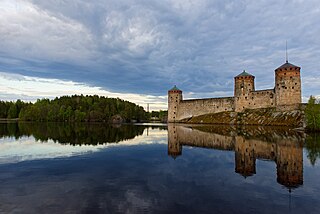
Olavinlinna is a 15th-century three-tower castle located in Savonlinna, Finland. It is built on an island in the Kyrönsalmi strait that connects the lakes Haukivesi and Pihlajavesi. It is the northernmost medieval stone fortress still standing. The castle forms a spectacular stage for the Savonlinna Opera Festival, which was held for the first time in the summer of 1912.

The Treaty of Stolbovo was a peace treaty that ended the Ingrian War, which had been fought between the Swedish Empire and the Russian Tsardom between 1610 and 1617.
Sverker II or Sverker the Younger was King of Sweden from 1195 or 1196 to 1208 when he was defeated in the Battle of Lena by Prince Eric. Sverker died in the 1210 Battle of Gestilren where his forces battled those of King Eric X.

The Battle of Gestilren took place on July 17, 1210. The battle was fought between the exiled King of Sweden Sverker and the ruling King Eric X. Sverker had been beaten in the previous Battle of Lena, but returned with new forces. Sverker was however killed in the battle. The exact strength of the armies is unknown.

The Russo-Swedish War of 1554–1557, considered a prelude to the Livonian War of 1558–1583, arose out of border skirmishes. It ended when the parties agreed on a truce in the Treaty of Novgorod (1557).
The Russo-Swedish War of 1656-1658, known as the War of Rupture, was fought by Russia and Sweden as a theater of the Second Northern War. It took place during a pause in the contemporary Russo-Polish War (1654–1667) as a consequence of the Truce of Vilna. Despite initial successes, Tsar Alexis of Russia failed to secure his principal objective—to revise the Treaty of Stolbovo, which had stripped Russia of the Baltic coast at the close of the Ingrian War.

The Third Swedish Crusade to Finland was a Swedish military expedition against the pagan Karelians from 1293 to 1295 in which the Swedes successfully expanded their borders eastwards and gained further control of their lands in Finland.

Lindholmen Castle was a Danish fortified castle on the banks of lake Börringe in Svedala Municipality in Scania, Sweden. The only thing left of the castle is the hill on which the castle was built and a few stones in the ground on top of the hill.
The Truce of Mitawa or Truce of Mitau, signed in November 1622 in Jelgava, ended the Polish–Swedish War (1620–1622).

The relations between Denmark and Sweden span a long history of interaction. The inhabitants of each speak related North Germanic languages, which have a degree of mutual intelligibility. Both countries formed part of the Kalmar Union between 1397 and 1523, but there exists an inherited cultural competition between Sweden and Denmark. From 1448 to 1790 the two kingdoms went to war against each other at nearly every opportunity; in more than one case a new king tried to prove his worth by waging war on the other country for little or no political reason. Eleven Dano-Swedish wars took place between 1521 and 1814.
The Battle of Lode was fought during the Livonian War, between a Swedish and Russian army on 23 January 1573. The battle was won by the Swedes.

Hans Wilhelm Kristofer Agrell is a Swedish writer and historian within the area of peace and conflict studies. His authorship has mostly focussed on Swedish foreign, security and defence policy during the Cold War.

The War in Gotland (1313), also known as the Tax war against the Gutes, was a short lived conflict fought between the forces of the Swedish King Birger, and the people of Gotland. The primary cause of the war was the high taxes imposed by Sweden on Gotland, which fueled anger and later resulted in the Gotlanders refusing to pay taxes.

The Attack on Åbo was a Novgorodian attack on the then Swedish city of Åbo in 1318, the Novgorodian goal of capturing the city failed, but they managed to burn the outskirts.

The Siege of Narva was a siege and massacre initiated by Pontus De la Gardie against the Russian-controlled city of Narva in present-day Estonia. The siege resulted in a victory for the Swedes.

The Swedish expedition to Livonia was a Swedish military offensive directed towards the land controlled by John III in the Baltic in 1562. Despite it being mainly against John III, the Swedes also captured fortresses under the Polish–Lithuanian union. The Swedes also managed to occupy a majority of northern Livonia.

The Estonian campaign, also called the Swedish offensive in Estonia was a Swedish offensive against land controlled by Denmark–Norway in Estonia in 1563, during the campaign, both the Polish–Lithuanian union and Duchy of Courland intervened on the Danish side. The Swedes were able to successfully occupy Leal and Hapsal and furthered their control in Estonia.













